Research Proposal: Cultural Diversity Management at Tesco UK
VerifiedAdded on 2023/01/04
|10
|2284
|76
Report
AI Summary
This research proposal outlines a study on the impact of cultural diversity management on employee satisfaction within Tesco, a major UK retailer. The proposal begins with background information on cultural diversity in organizations and Tesco's operations, followed by a research rationale highlighting the importance of managing diversity in the competitive retail landscape. The research aims to analyze the impact of cultural diversity management on employee satisfaction, identify challenges, and recommend strategies for improvement. The research questions explore the concept of cultural diversity management, its impact on employee satisfaction, challenges, and potential strategies. The methodology will employ an inductive research approach, utilizing both primary and secondary data sources, including literature reviews and questionnaires distributed to 30 managers using purposive sampling. The research will use a qualitative approach, focusing on thematic analysis of the data collected. The timescale for the research is set at 11 weeks. The proposal also includes a comprehensive list of references.

RESEARCH PROPOSAL
Paraphrase This Document
Need a fresh take? Get an instant paraphrase of this document with our AI Paraphraser
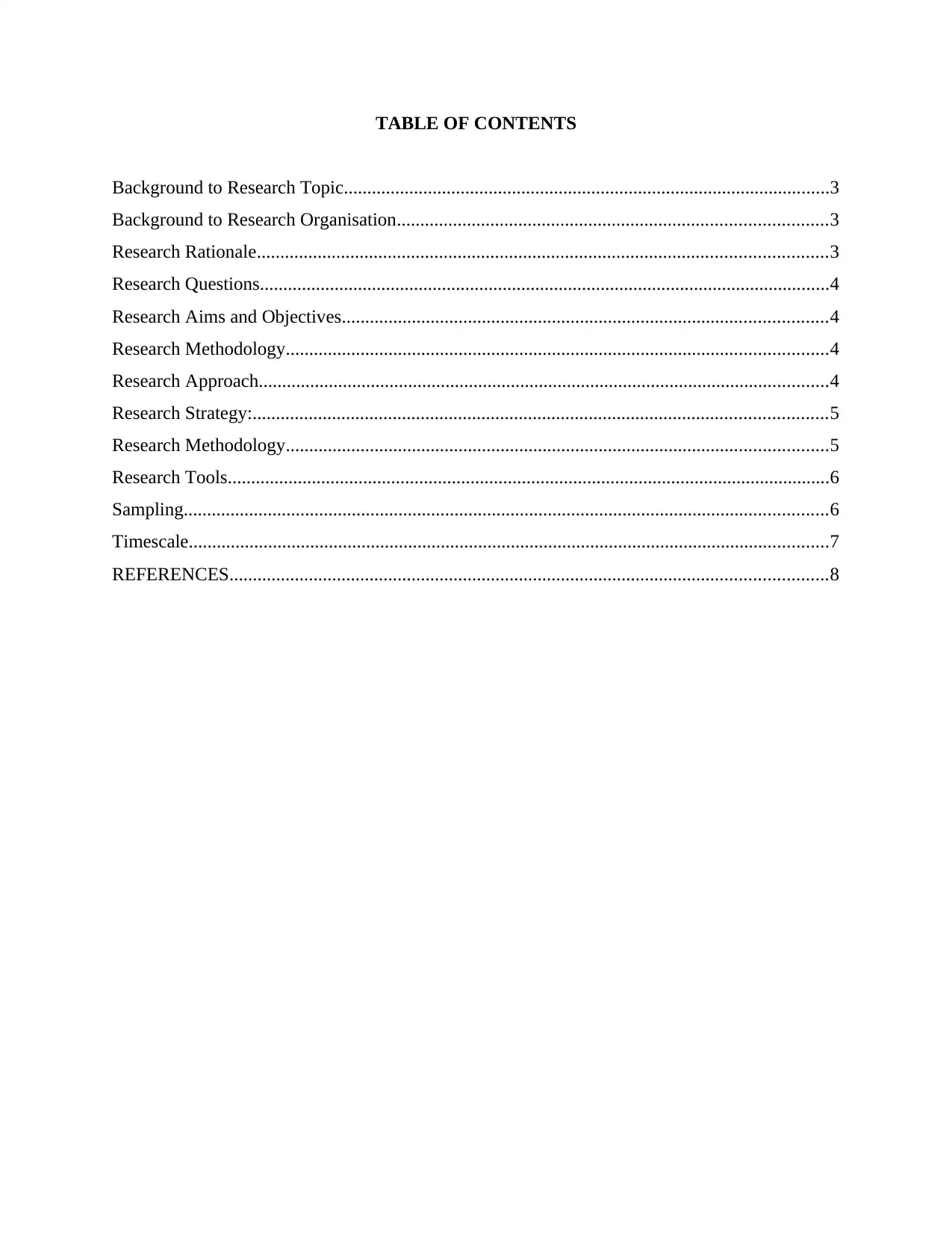
TABLE OF CONTENTS
Background to Research Topic........................................................................................................3
Background to Research Organisation............................................................................................3
Research Rationale..........................................................................................................................3
Research Questions..........................................................................................................................4
Research Aims and Objectives........................................................................................................4
Research Methodology....................................................................................................................4
Research Approach..........................................................................................................................4
Research Strategy:...........................................................................................................................5
Research Methodology....................................................................................................................5
Research Tools.................................................................................................................................6
Sampling..........................................................................................................................................6
Timescale.........................................................................................................................................7
REFERENCES................................................................................................................................8
Background to Research Topic........................................................................................................3
Background to Research Organisation............................................................................................3
Research Rationale..........................................................................................................................3
Research Questions..........................................................................................................................4
Research Aims and Objectives........................................................................................................4
Research Methodology....................................................................................................................4
Research Approach..........................................................................................................................4
Research Strategy:...........................................................................................................................5
Research Methodology....................................................................................................................5
Research Tools.................................................................................................................................6
Sampling..........................................................................................................................................6
Timescale.........................................................................................................................................7
REFERENCES................................................................................................................................8
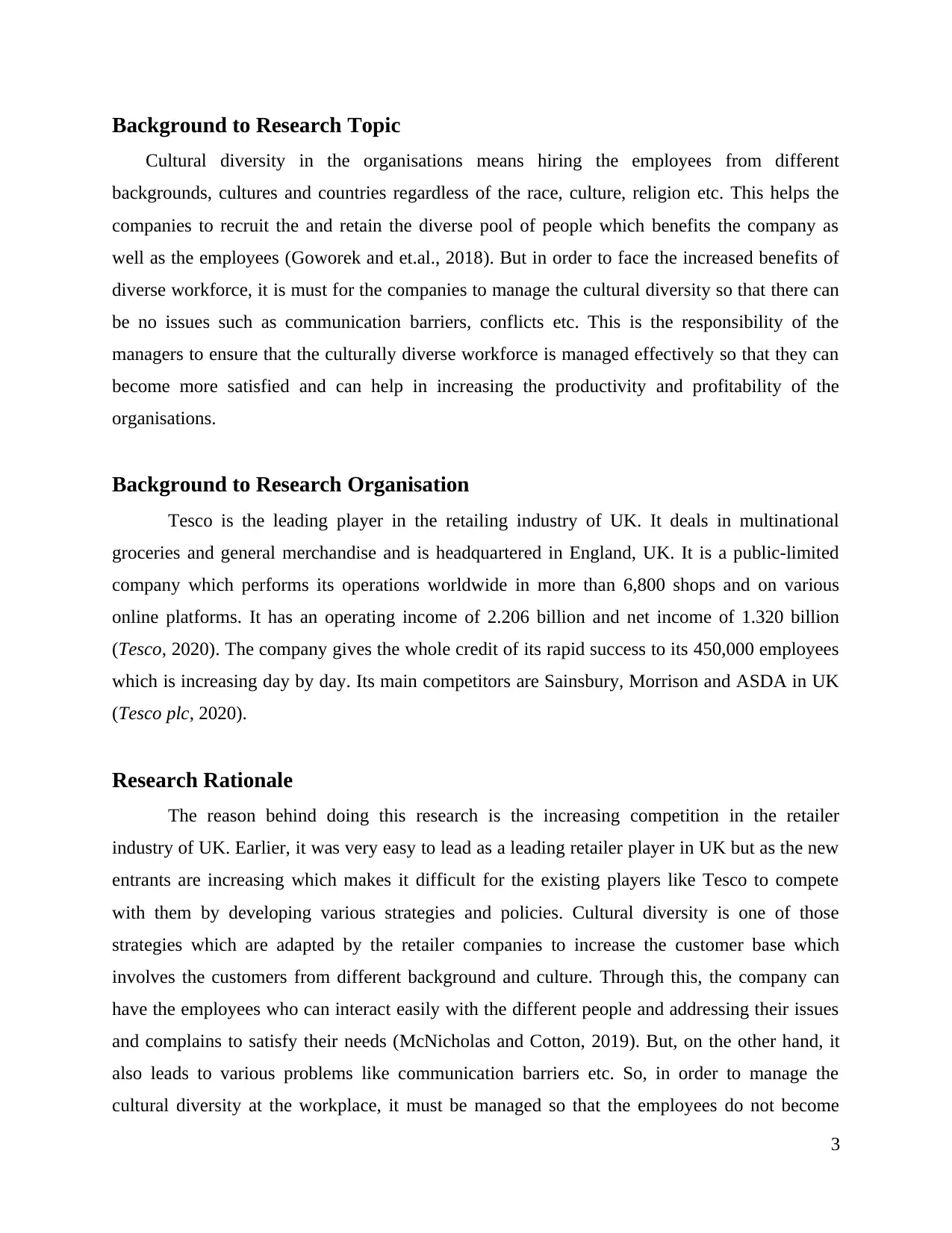
Background to Research Topic
Cultural diversity in the organisations means hiring the employees from different
backgrounds, cultures and countries regardless of the race, culture, religion etc. This helps the
companies to recruit the and retain the diverse pool of people which benefits the company as
well as the employees (Goworek and et.al., 2018). But in order to face the increased benefits of
diverse workforce, it is must for the companies to manage the cultural diversity so that there can
be no issues such as communication barriers, conflicts etc. This is the responsibility of the
managers to ensure that the culturally diverse workforce is managed effectively so that they can
become more satisfied and can help in increasing the productivity and profitability of the
organisations.
Background to Research Organisation
Tesco is the leading player in the retailing industry of UK. It deals in multinational
groceries and general merchandise and is headquartered in England, UK. It is a public-limited
company which performs its operations worldwide in more than 6,800 shops and on various
online platforms. It has an operating income of 2.206 billion and net income of 1.320 billion
(Tesco, 2020). The company gives the whole credit of its rapid success to its 450,000 employees
which is increasing day by day. Its main competitors are Sainsbury, Morrison and ASDA in UK
(Tesco plc, 2020).
Research Rationale
The reason behind doing this research is the increasing competition in the retailer
industry of UK. Earlier, it was very easy to lead as a leading retailer player in UK but as the new
entrants are increasing which makes it difficult for the existing players like Tesco to compete
with them by developing various strategies and policies. Cultural diversity is one of those
strategies which are adapted by the retailer companies to increase the customer base which
involves the customers from different background and culture. Through this, the company can
have the employees who can interact easily with the different people and addressing their issues
and complains to satisfy their needs (McNicholas and Cotton, 2019). But, on the other hand, it
also leads to various problems like communication barriers etc. So, in order to manage the
cultural diversity at the workplace, it must be managed so that the employees do not become
3
Cultural diversity in the organisations means hiring the employees from different
backgrounds, cultures and countries regardless of the race, culture, religion etc. This helps the
companies to recruit the and retain the diverse pool of people which benefits the company as
well as the employees (Goworek and et.al., 2018). But in order to face the increased benefits of
diverse workforce, it is must for the companies to manage the cultural diversity so that there can
be no issues such as communication barriers, conflicts etc. This is the responsibility of the
managers to ensure that the culturally diverse workforce is managed effectively so that they can
become more satisfied and can help in increasing the productivity and profitability of the
organisations.
Background to Research Organisation
Tesco is the leading player in the retailing industry of UK. It deals in multinational
groceries and general merchandise and is headquartered in England, UK. It is a public-limited
company which performs its operations worldwide in more than 6,800 shops and on various
online platforms. It has an operating income of 2.206 billion and net income of 1.320 billion
(Tesco, 2020). The company gives the whole credit of its rapid success to its 450,000 employees
which is increasing day by day. Its main competitors are Sainsbury, Morrison and ASDA in UK
(Tesco plc, 2020).
Research Rationale
The reason behind doing this research is the increasing competition in the retailer
industry of UK. Earlier, it was very easy to lead as a leading retailer player in UK but as the new
entrants are increasing which makes it difficult for the existing players like Tesco to compete
with them by developing various strategies and policies. Cultural diversity is one of those
strategies which are adapted by the retailer companies to increase the customer base which
involves the customers from different background and culture. Through this, the company can
have the employees who can interact easily with the different people and addressing their issues
and complains to satisfy their needs (McNicholas and Cotton, 2019). But, on the other hand, it
also leads to various problems like communication barriers etc. So, in order to manage the
cultural diversity at the workplace, it must be managed so that the employees do not become
3
⊘ This is a preview!⊘
Do you want full access?
Subscribe today to unlock all pages.

Trusted by 1+ million students worldwide
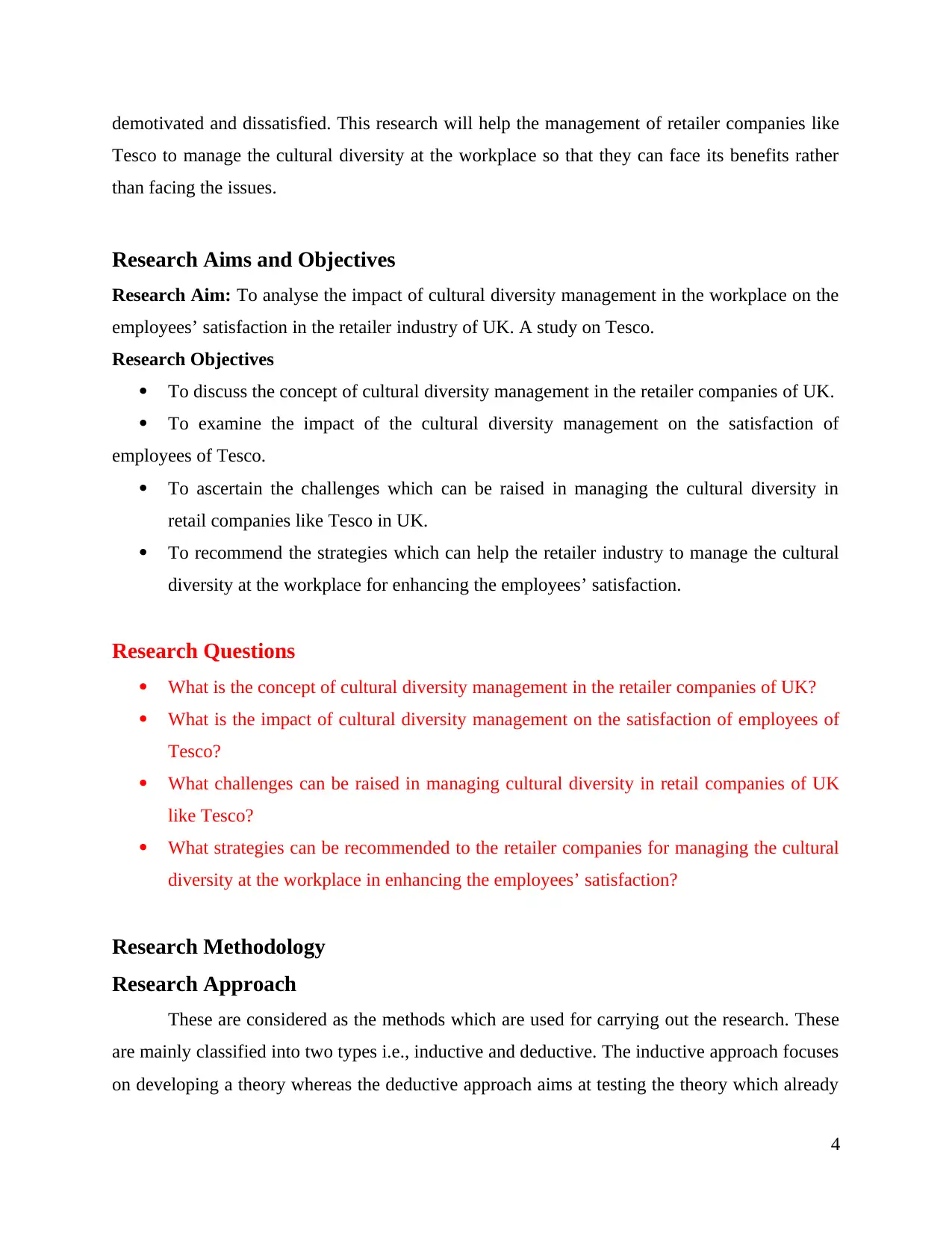
demotivated and dissatisfied. This research will help the management of retailer companies like
Tesco to manage the cultural diversity at the workplace so that they can face its benefits rather
than facing the issues.
Research Aims and Objectives
Research Aim: To analyse the impact of cultural diversity management in the workplace on the
employees’ satisfaction in the retailer industry of UK. A study on Tesco.
Research Objectives
To discuss the concept of cultural diversity management in the retailer companies of UK.
To examine the impact of the cultural diversity management on the satisfaction of
employees of Tesco.
To ascertain the challenges which can be raised in managing the cultural diversity in
retail companies like Tesco in UK.
To recommend the strategies which can help the retailer industry to manage the cultural
diversity at the workplace for enhancing the employees’ satisfaction.
Research Questions
What is the concept of cultural diversity management in the retailer companies of UK?
What is the impact of cultural diversity management on the satisfaction of employees of
Tesco?
What challenges can be raised in managing cultural diversity in retail companies of UK
like Tesco?
What strategies can be recommended to the retailer companies for managing the cultural
diversity at the workplace in enhancing the employees’ satisfaction?
Research Methodology
Research Approach
These are considered as the methods which are used for carrying out the research. These
are mainly classified into two types i.e., inductive and deductive. The inductive approach focuses
on developing a theory whereas the deductive approach aims at testing the theory which already
4
Tesco to manage the cultural diversity at the workplace so that they can face its benefits rather
than facing the issues.
Research Aims and Objectives
Research Aim: To analyse the impact of cultural diversity management in the workplace on the
employees’ satisfaction in the retailer industry of UK. A study on Tesco.
Research Objectives
To discuss the concept of cultural diversity management in the retailer companies of UK.
To examine the impact of the cultural diversity management on the satisfaction of
employees of Tesco.
To ascertain the challenges which can be raised in managing the cultural diversity in
retail companies like Tesco in UK.
To recommend the strategies which can help the retailer industry to manage the cultural
diversity at the workplace for enhancing the employees’ satisfaction.
Research Questions
What is the concept of cultural diversity management in the retailer companies of UK?
What is the impact of cultural diversity management on the satisfaction of employees of
Tesco?
What challenges can be raised in managing cultural diversity in retail companies of UK
like Tesco?
What strategies can be recommended to the retailer companies for managing the cultural
diversity at the workplace in enhancing the employees’ satisfaction?
Research Methodology
Research Approach
These are considered as the methods which are used for carrying out the research. These
are mainly classified into two types i.e., inductive and deductive. The inductive approach focuses
on developing a theory whereas the deductive approach aims at testing the theory which already
4
Paraphrase This Document
Need a fresh take? Get an instant paraphrase of this document with our AI Paraphraser
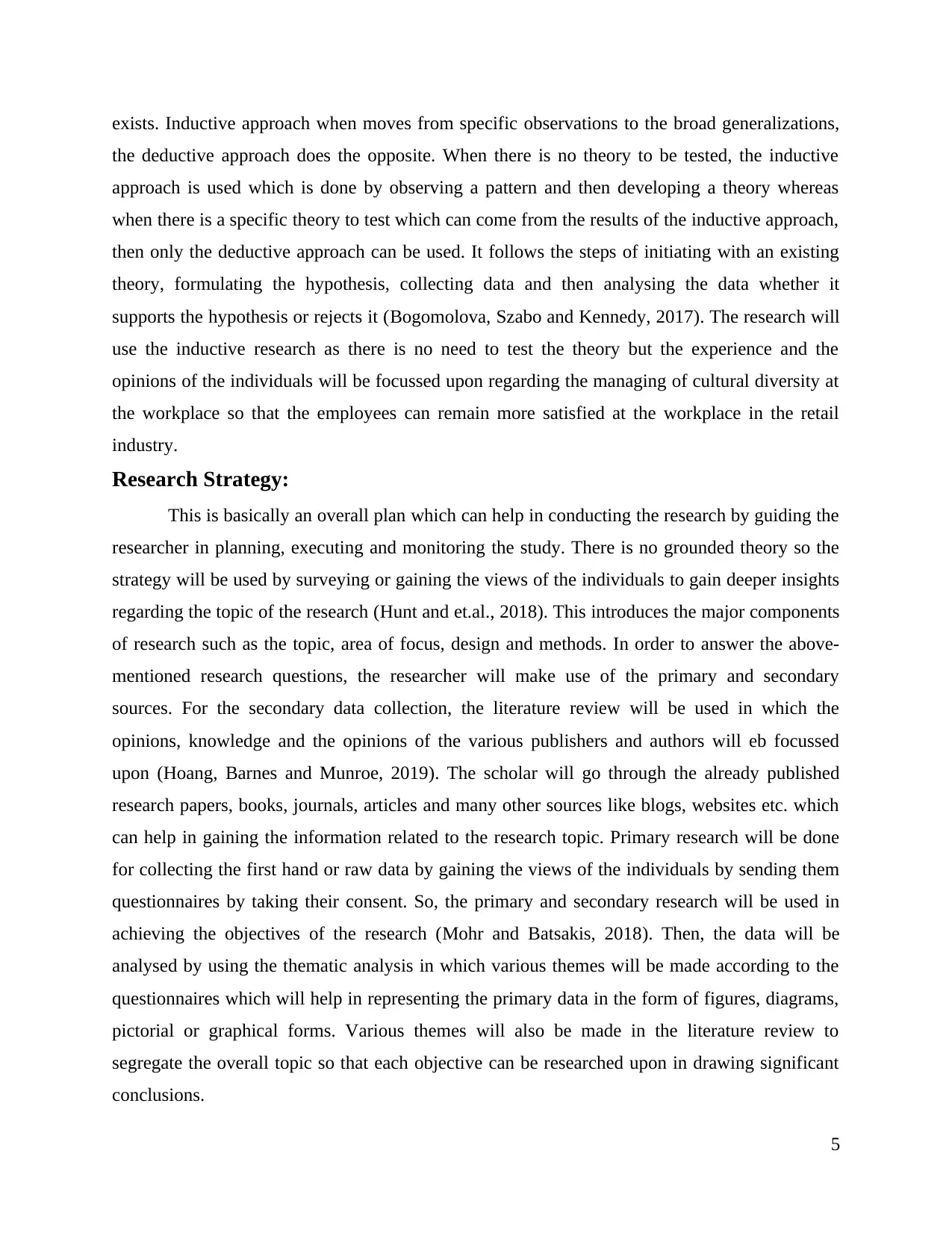
exists. Inductive approach when moves from specific observations to the broad generalizations,
the deductive approach does the opposite. When there is no theory to be tested, the inductive
approach is used which is done by observing a pattern and then developing a theory whereas
when there is a specific theory to test which can come from the results of the inductive approach,
then only the deductive approach can be used. It follows the steps of initiating with an existing
theory, formulating the hypothesis, collecting data and then analysing the data whether it
supports the hypothesis or rejects it (Bogomolova, Szabo and Kennedy, 2017). The research will
use the inductive research as there is no need to test the theory but the experience and the
opinions of the individuals will be focussed upon regarding the managing of cultural diversity at
the workplace so that the employees can remain more satisfied at the workplace in the retail
industry.
Research Strategy:
This is basically an overall plan which can help in conducting the research by guiding the
researcher in planning, executing and monitoring the study. There is no grounded theory so the
strategy will be used by surveying or gaining the views of the individuals to gain deeper insights
regarding the topic of the research (Hunt and et.al., 2018). This introduces the major components
of research such as the topic, area of focus, design and methods. In order to answer the above-
mentioned research questions, the researcher will make use of the primary and secondary
sources. For the secondary data collection, the literature review will be used in which the
opinions, knowledge and the opinions of the various publishers and authors will eb focussed
upon (Hoang, Barnes and Munroe, 2019). The scholar will go through the already published
research papers, books, journals, articles and many other sources like blogs, websites etc. which
can help in gaining the information related to the research topic. Primary research will be done
for collecting the first hand or raw data by gaining the views of the individuals by sending them
questionnaires by taking their consent. So, the primary and secondary research will be used in
achieving the objectives of the research (Mohr and Batsakis, 2018). Then, the data will be
analysed by using the thematic analysis in which various themes will be made according to the
questionnaires which will help in representing the primary data in the form of figures, diagrams,
pictorial or graphical forms. Various themes will also be made in the literature review to
segregate the overall topic so that each objective can be researched upon in drawing significant
conclusions.
5
the deductive approach does the opposite. When there is no theory to be tested, the inductive
approach is used which is done by observing a pattern and then developing a theory whereas
when there is a specific theory to test which can come from the results of the inductive approach,
then only the deductive approach can be used. It follows the steps of initiating with an existing
theory, formulating the hypothesis, collecting data and then analysing the data whether it
supports the hypothesis or rejects it (Bogomolova, Szabo and Kennedy, 2017). The research will
use the inductive research as there is no need to test the theory but the experience and the
opinions of the individuals will be focussed upon regarding the managing of cultural diversity at
the workplace so that the employees can remain more satisfied at the workplace in the retail
industry.
Research Strategy:
This is basically an overall plan which can help in conducting the research by guiding the
researcher in planning, executing and monitoring the study. There is no grounded theory so the
strategy will be used by surveying or gaining the views of the individuals to gain deeper insights
regarding the topic of the research (Hunt and et.al., 2018). This introduces the major components
of research such as the topic, area of focus, design and methods. In order to answer the above-
mentioned research questions, the researcher will make use of the primary and secondary
sources. For the secondary data collection, the literature review will be used in which the
opinions, knowledge and the opinions of the various publishers and authors will eb focussed
upon (Hoang, Barnes and Munroe, 2019). The scholar will go through the already published
research papers, books, journals, articles and many other sources like blogs, websites etc. which
can help in gaining the information related to the research topic. Primary research will be done
for collecting the first hand or raw data by gaining the views of the individuals by sending them
questionnaires by taking their consent. So, the primary and secondary research will be used in
achieving the objectives of the research (Mohr and Batsakis, 2018). Then, the data will be
analysed by using the thematic analysis in which various themes will be made according to the
questionnaires which will help in representing the primary data in the form of figures, diagrams,
pictorial or graphical forms. Various themes will also be made in the literature review to
segregate the overall topic so that each objective can be researched upon in drawing significant
conclusions.
5
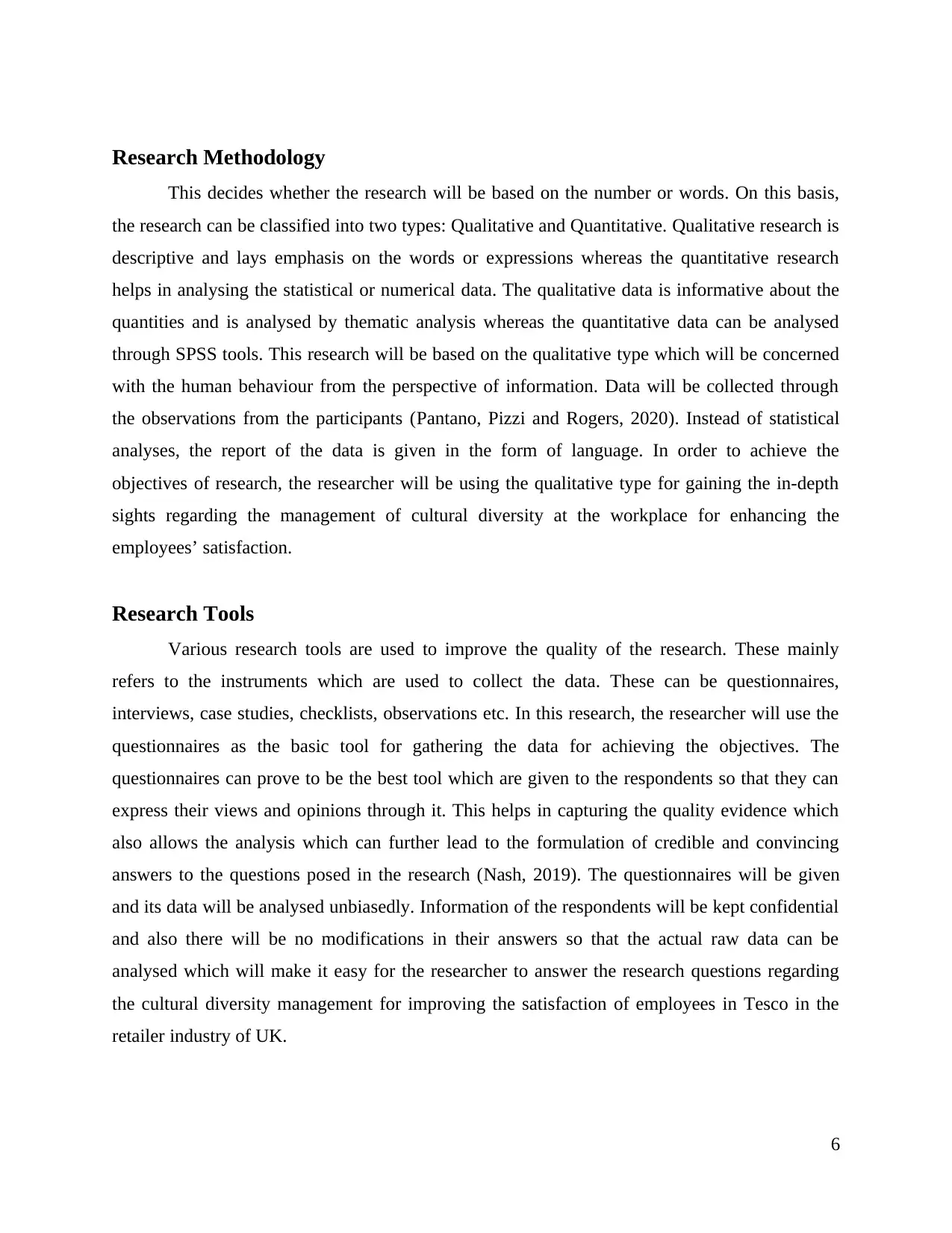
Research Methodology
This decides whether the research will be based on the number or words. On this basis,
the research can be classified into two types: Qualitative and Quantitative. Qualitative research is
descriptive and lays emphasis on the words or expressions whereas the quantitative research
helps in analysing the statistical or numerical data. The qualitative data is informative about the
quantities and is analysed by thematic analysis whereas the quantitative data can be analysed
through SPSS tools. This research will be based on the qualitative type which will be concerned
with the human behaviour from the perspective of information. Data will be collected through
the observations from the participants (Pantano, Pizzi and Rogers, 2020). Instead of statistical
analyses, the report of the data is given in the form of language. In order to achieve the
objectives of research, the researcher will be using the qualitative type for gaining the in-depth
sights regarding the management of cultural diversity at the workplace for enhancing the
employees’ satisfaction.
Research Tools
Various research tools are used to improve the quality of the research. These mainly
refers to the instruments which are used to collect the data. These can be questionnaires,
interviews, case studies, checklists, observations etc. In this research, the researcher will use the
questionnaires as the basic tool for gathering the data for achieving the objectives. The
questionnaires can prove to be the best tool which are given to the respondents so that they can
express their views and opinions through it. This helps in capturing the quality evidence which
also allows the analysis which can further lead to the formulation of credible and convincing
answers to the questions posed in the research (Nash, 2019). The questionnaires will be given
and its data will be analysed unbiasedly. Information of the respondents will be kept confidential
and also there will be no modifications in their answers so that the actual raw data can be
analysed which will make it easy for the researcher to answer the research questions regarding
the cultural diversity management for improving the satisfaction of employees in Tesco in the
retailer industry of UK.
6
This decides whether the research will be based on the number or words. On this basis,
the research can be classified into two types: Qualitative and Quantitative. Qualitative research is
descriptive and lays emphasis on the words or expressions whereas the quantitative research
helps in analysing the statistical or numerical data. The qualitative data is informative about the
quantities and is analysed by thematic analysis whereas the quantitative data can be analysed
through SPSS tools. This research will be based on the qualitative type which will be concerned
with the human behaviour from the perspective of information. Data will be collected through
the observations from the participants (Pantano, Pizzi and Rogers, 2020). Instead of statistical
analyses, the report of the data is given in the form of language. In order to achieve the
objectives of research, the researcher will be using the qualitative type for gaining the in-depth
sights regarding the management of cultural diversity at the workplace for enhancing the
employees’ satisfaction.
Research Tools
Various research tools are used to improve the quality of the research. These mainly
refers to the instruments which are used to collect the data. These can be questionnaires,
interviews, case studies, checklists, observations etc. In this research, the researcher will use the
questionnaires as the basic tool for gathering the data for achieving the objectives. The
questionnaires can prove to be the best tool which are given to the respondents so that they can
express their views and opinions through it. This helps in capturing the quality evidence which
also allows the analysis which can further lead to the formulation of credible and convincing
answers to the questions posed in the research (Nash, 2019). The questionnaires will be given
and its data will be analysed unbiasedly. Information of the respondents will be kept confidential
and also there will be no modifications in their answers so that the actual raw data can be
analysed which will make it easy for the researcher to answer the research questions regarding
the cultural diversity management for improving the satisfaction of employees in Tesco in the
retailer industry of UK.
6
⊘ This is a preview!⊘
Do you want full access?
Subscribe today to unlock all pages.

Trusted by 1+ million students worldwide
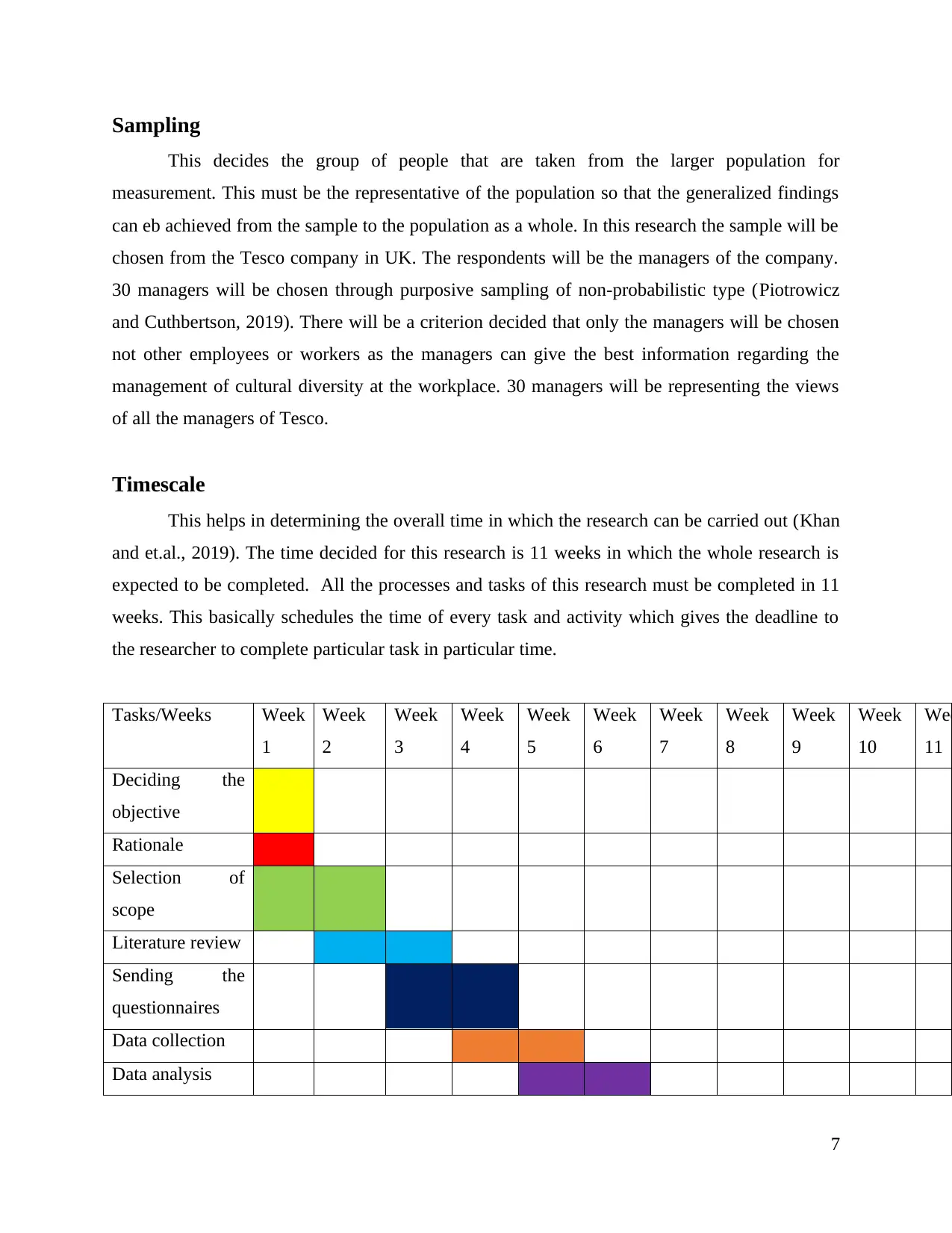
Sampling
This decides the group of people that are taken from the larger population for
measurement. This must be the representative of the population so that the generalized findings
can eb achieved from the sample to the population as a whole. In this research the sample will be
chosen from the Tesco company in UK. The respondents will be the managers of the company.
30 managers will be chosen through purposive sampling of non-probabilistic type (Piotrowicz
and Cuthbertson, 2019). There will be a criterion decided that only the managers will be chosen
not other employees or workers as the managers can give the best information regarding the
management of cultural diversity at the workplace. 30 managers will be representing the views
of all the managers of Tesco.
Timescale
This helps in determining the overall time in which the research can be carried out (Khan
and et.al., 2019). The time decided for this research is 11 weeks in which the whole research is
expected to be completed. All the processes and tasks of this research must be completed in 11
weeks. This basically schedules the time of every task and activity which gives the deadline to
the researcher to complete particular task in particular time.
Tasks/Weeks Week
1
Week
2
Week
3
Week
4
Week
5
Week
6
Week
7
Week
8
Week
9
Week
10
Wee
11
Deciding the
objective
Rationale
Selection of
scope
Literature review
Sending the
questionnaires
Data collection
Data analysis
7
This decides the group of people that are taken from the larger population for
measurement. This must be the representative of the population so that the generalized findings
can eb achieved from the sample to the population as a whole. In this research the sample will be
chosen from the Tesco company in UK. The respondents will be the managers of the company.
30 managers will be chosen through purposive sampling of non-probabilistic type (Piotrowicz
and Cuthbertson, 2019). There will be a criterion decided that only the managers will be chosen
not other employees or workers as the managers can give the best information regarding the
management of cultural diversity at the workplace. 30 managers will be representing the views
of all the managers of Tesco.
Timescale
This helps in determining the overall time in which the research can be carried out (Khan
and et.al., 2019). The time decided for this research is 11 weeks in which the whole research is
expected to be completed. All the processes and tasks of this research must be completed in 11
weeks. This basically schedules the time of every task and activity which gives the deadline to
the researcher to complete particular task in particular time.
Tasks/Weeks Week
1
Week
2
Week
3
Week
4
Week
5
Week
6
Week
7
Week
8
Week
9
Week
10
Wee
11
Deciding the
objective
Rationale
Selection of
scope
Literature review
Sending the
questionnaires
Data collection
Data analysis
7
Paraphrase This Document
Need a fresh take? Get an instant paraphrase of this document with our AI Paraphraser
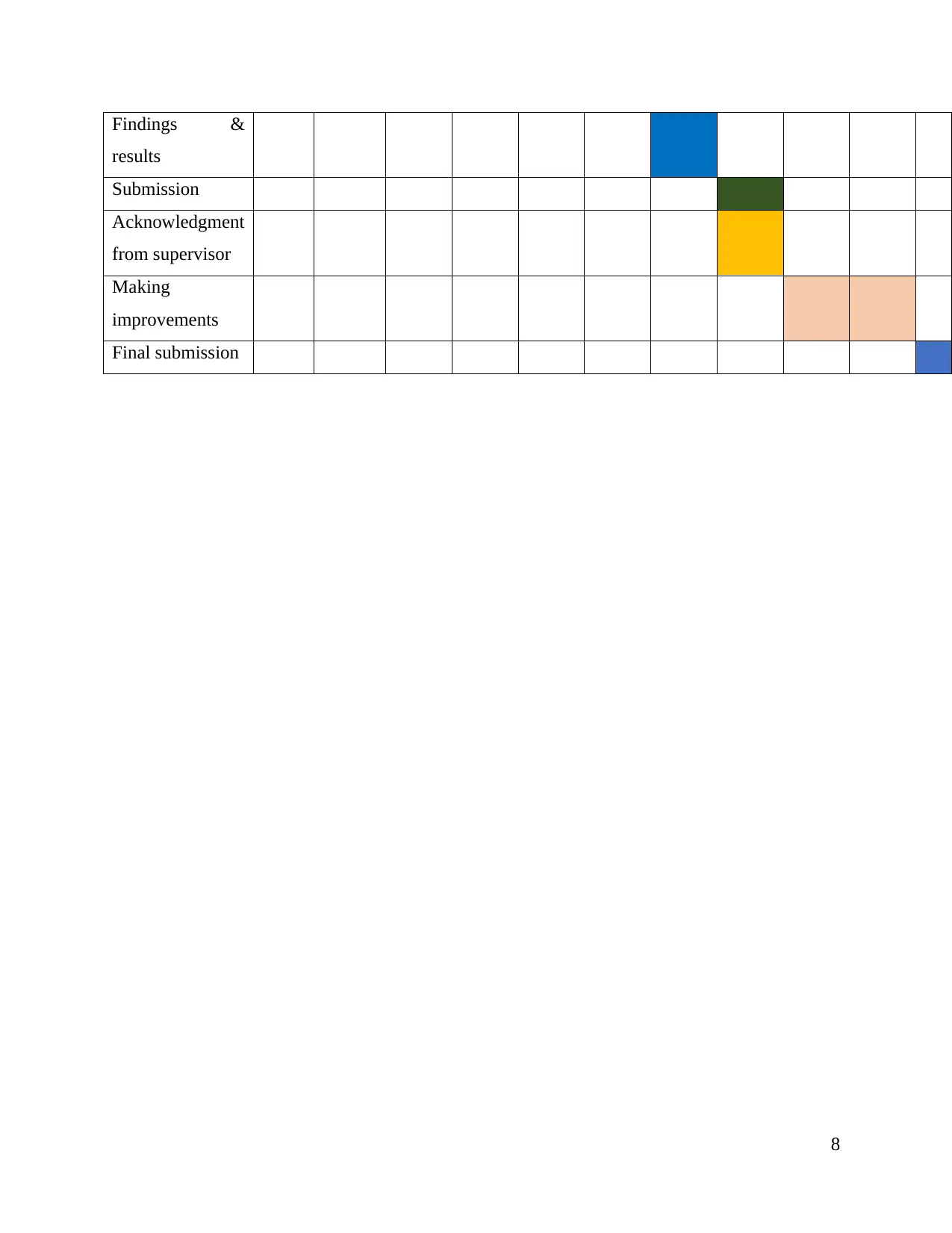
Findings &
results
Submission
Acknowledgment
from supervisor
Making
improvements
Final submission
8
results
Submission
Acknowledgment
from supervisor
Making
improvements
Final submission
8
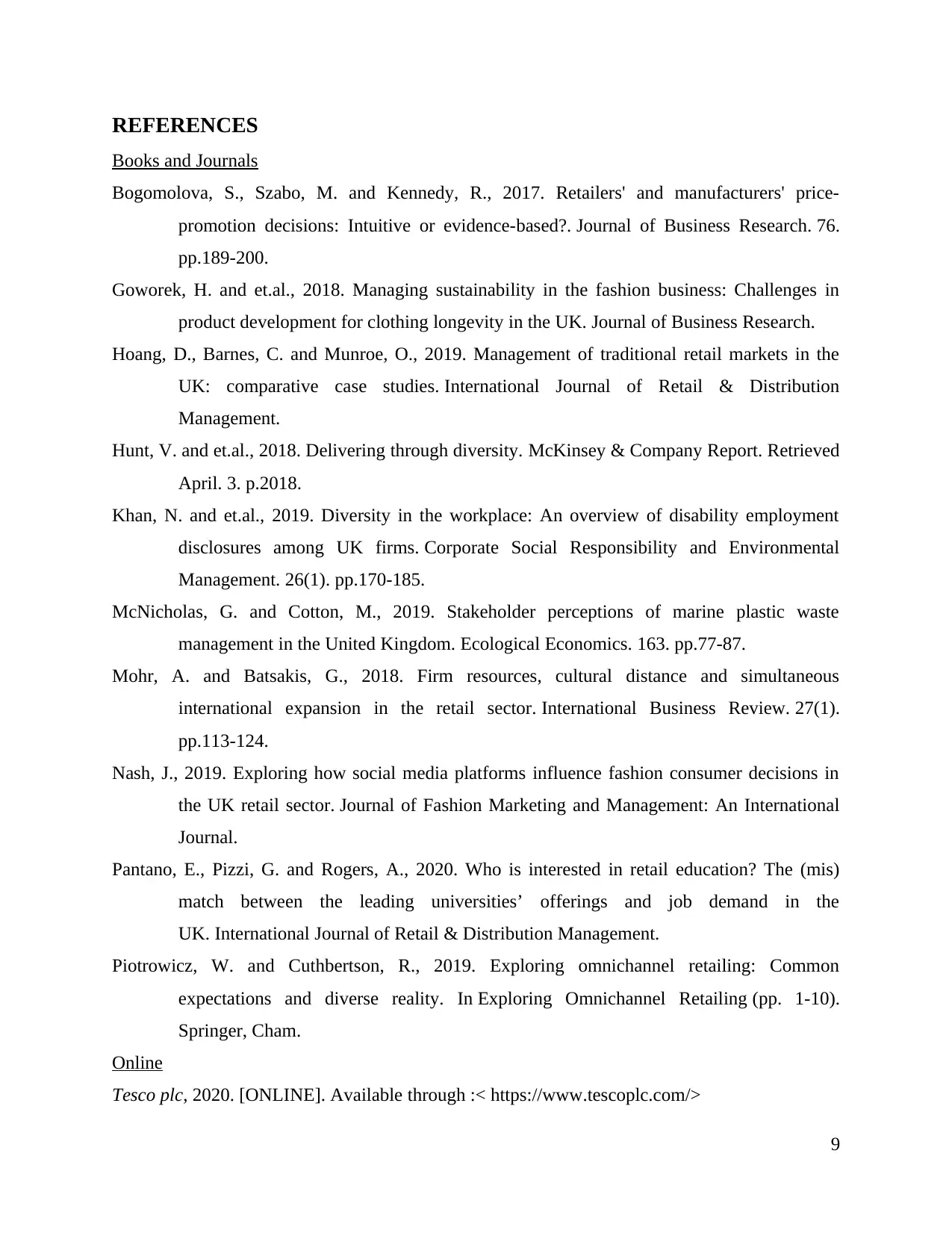
REFERENCES
Books and Journals
Bogomolova, S., Szabo, M. and Kennedy, R., 2017. Retailers' and manufacturers' price-
promotion decisions: Intuitive or evidence-based?. Journal of Business Research. 76.
pp.189-200.
Goworek, H. and et.al., 2018. Managing sustainability in the fashion business: Challenges in
product development for clothing longevity in the UK. Journal of Business Research.
Hoang, D., Barnes, C. and Munroe, O., 2019. Management of traditional retail markets in the
UK: comparative case studies. International Journal of Retail & Distribution
Management.
Hunt, V. and et.al., 2018. Delivering through diversity. McKinsey & Company Report. Retrieved
April. 3. p.2018.
Khan, N. and et.al., 2019. Diversity in the workplace: An overview of disability employment
disclosures among UK firms. Corporate Social Responsibility and Environmental
Management. 26(1). pp.170-185.
McNicholas, G. and Cotton, M., 2019. Stakeholder perceptions of marine plastic waste
management in the United Kingdom. Ecological Economics. 163. pp.77-87.
Mohr, A. and Batsakis, G., 2018. Firm resources, cultural distance and simultaneous
international expansion in the retail sector. International Business Review. 27(1).
pp.113-124.
Nash, J., 2019. Exploring how social media platforms influence fashion consumer decisions in
the UK retail sector. Journal of Fashion Marketing and Management: An International
Journal.
Pantano, E., Pizzi, G. and Rogers, A., 2020. Who is interested in retail education? The (mis)
match between the leading universities’ offerings and job demand in the
UK. International Journal of Retail & Distribution Management.
Piotrowicz, W. and Cuthbertson, R., 2019. Exploring omnichannel retailing: Common
expectations and diverse reality. In Exploring Omnichannel Retailing (pp. 1-10).
Springer, Cham.
Online
Tesco plc, 2020. [ONLINE]. Available through :< https://www.tescoplc.com/>
9
Books and Journals
Bogomolova, S., Szabo, M. and Kennedy, R., 2017. Retailers' and manufacturers' price-
promotion decisions: Intuitive or evidence-based?. Journal of Business Research. 76.
pp.189-200.
Goworek, H. and et.al., 2018. Managing sustainability in the fashion business: Challenges in
product development for clothing longevity in the UK. Journal of Business Research.
Hoang, D., Barnes, C. and Munroe, O., 2019. Management of traditional retail markets in the
UK: comparative case studies. International Journal of Retail & Distribution
Management.
Hunt, V. and et.al., 2018. Delivering through diversity. McKinsey & Company Report. Retrieved
April. 3. p.2018.
Khan, N. and et.al., 2019. Diversity in the workplace: An overview of disability employment
disclosures among UK firms. Corporate Social Responsibility and Environmental
Management. 26(1). pp.170-185.
McNicholas, G. and Cotton, M., 2019. Stakeholder perceptions of marine plastic waste
management in the United Kingdom. Ecological Economics. 163. pp.77-87.
Mohr, A. and Batsakis, G., 2018. Firm resources, cultural distance and simultaneous
international expansion in the retail sector. International Business Review. 27(1).
pp.113-124.
Nash, J., 2019. Exploring how social media platforms influence fashion consumer decisions in
the UK retail sector. Journal of Fashion Marketing and Management: An International
Journal.
Pantano, E., Pizzi, G. and Rogers, A., 2020. Who is interested in retail education? The (mis)
match between the leading universities’ offerings and job demand in the
UK. International Journal of Retail & Distribution Management.
Piotrowicz, W. and Cuthbertson, R., 2019. Exploring omnichannel retailing: Common
expectations and diverse reality. In Exploring Omnichannel Retailing (pp. 1-10).
Springer, Cham.
Online
Tesco plc, 2020. [ONLINE]. Available through :< https://www.tescoplc.com/>
9
⊘ This is a preview!⊘
Do you want full access?
Subscribe today to unlock all pages.

Trusted by 1+ million students worldwide

Tesco, 2020. [ONLINE]. Available through :< https://www.tesco.com/>
10
10
1 out of 10
Related Documents
Your All-in-One AI-Powered Toolkit for Academic Success.
+13062052269
info@desklib.com
Available 24*7 on WhatsApp / Email
![[object Object]](/_next/static/media/star-bottom.7253800d.svg)
Unlock your academic potential
Copyright © 2020–2025 A2Z Services. All Rights Reserved. Developed and managed by ZUCOL.





